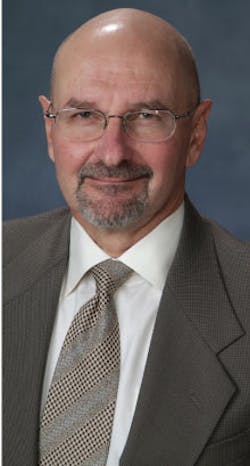I recently attended the Strategies in Light event in Santa Clara, Calif., the largest conference on high-brightness LED. It’s largely a technical conference with dozens of PhD’s presenting research and updates on all things LED: epitaxy, thermal efficiency, color, substrate composition, etc. The subject matter of these presentations was well beyond the day-to-day conversations of “electrical” guys like me or most of our clients.
I was invited to speak at the conference on the topic of “The Future of Lighting” (presentation available at www.egretconsulting.com or in my LinkedIn profile). A large part of my presentation was dedicated to the impacts of new technology on design. The design community will largely re-set the electrical industry over the next few years. Most of the technology is already viable and financially justifiable. Let’s summarize the key issues.
Market size. Lighting is generally estimated to be 10-12% of the overall electrical industry. That represents $10 billion to $12 billion annually in the United States. Those dollars have traditionally been generated throughout electrical distribution, electrical contractors, lighting reps, lighting showrooms and hundreds of lighting manufacturers.
Industry impact. Lighting impacts the electrical industry significantly through the upstream and downstream products it requires: steel boxes, wire, conduit, transformers, panels, breakers, switches, wiring devices, dimmers, occupancy sensors, connectors and the installation and repair of all of these devices.
Technological capabilities of LEDs. Solid-state lighting has ready-now technology that will transform a complete lighting design into a package where each LED fixture can be an IP-addressable node on a wireless or VoIP control system; be powered by a low-voltage cable and be connected via Cat 6 or USB connectors; and be controlled via wireless commands from a central software system. LED lighting systems will require “commissioning” to ensure they communicate within the overall building automation system. And LED fixtures have some dramatically different components than the traditional lighting fixtures you have grown up with, because they have a PC board, power supply and heat sink.
There was an interesting presentation at the Strategies in Light conference from an executive with IKEA stores. She said lighting is a large part of their commitment to sustainability, and asked the question, “If we started designing lighting fixtures today; would we really need lampshades?”
That question gave me an idea for a new “rant” on the state of lighting design. LEDs are currently being designed and repackaged into the same fixture bodies of the past, including 2x2s, wallpacks, troffers, downlights and floodlights. There is no rational or functional reason for jamming LED packages into assemblies designed for large, bulbous, spherically luminous bulbs. The most logical reason for doing this is simply because the tooling is already done — and the mental energy required to overcome the inertia of 100-plus years of traditional lighting is too great.
LED technology has completed Phase 1, as the efficiency of LEDs as a lumen package is now sufficient to supplant most of the traditional light sources. As the efficiency rises even more, the cost of LED systems will easily be within reach as the most logical light source for future design. With sufficient lumen firepower, the next challenge in the industry is to develop innovative designs that allow for lighting to integrate into complete building design systems — cross-linked into HVAC, daylighting, security, sound, datacom and motion detection systems.
The applications for LED technology are endless. You can already buy a wi-fi enabled light bulb today, or purchase street lighting systems that raise or lower the brightness dependent upon traffic patterns; the same is now available for parking garage lighting. Street lighting can be specified optically to light a rectangular or curved pattern.
The implications for the transition of lighting are enormous. With solid-state lighting (SSL), there will be very little need for conduit and steel boxes or the IBEW labor to install those. Lighting consumes around 40% of the nation’s energy supplied to commercial buildings. That also means lighting design requires electrical design for that consumption of power and the HVAC design to cool that amount of heat. So panel sizes, transformer sizes, refrigerant loads, number of circuits and wire sizes will all drop proportional to the lowered power demands of SSL.
Designs of the future will drastically change the size, look, feel and installation features of lighting equipment. The basic concept of a lighting fixture may be obsolete and may very well be replaced with a lighting node. Because of this huge change, I think the need for a close interchange of ideas between fixture designers and lighting designers is critical. As lighting will interface within the overall electronic control systems of buildings, the migration of lighting and all things “informational” will be essential. A potential merger or alliance between CEDIA (Custom Electronics Design & Installation Association) and its membership of professionals serving the markets for home theater, audio, video and residential electronic systems and IES (Illuminating Engineering Society) and its lighting professionals would be desirable, as CEDIA members are trained to install sound, data and communication systems. I think the electrical contractor and most electrical distributors will see the end of lighting as a revenue stream for them. The next generation of lighting guys may well be network interface people who bundle lighting into their purview, likely to the demise of good lighting design.
Ted Konnerth is president/CEO of Egret Consulting Group, Mundelein, Ill., a retained search firm with specialties in the electrical market, consulting services (architectural and engineering), and mergers and acquisitions consulting. Prior to founding Egret Consulting in 1999, Konnerth was Cooper Lighting’s vice president of sales. Contact info: (847) 307-7125; or [email protected]; website: www.egretconsulting.com.
About the Author

Ted Konnerth
President / CEO
Ted Konnerth is president/CEO of Egret Consulting Group, Mundelein, Ill., a retained search firm with specialties in the electrical market, consulting services (architectural and engineering), and mergers and acquisitions consulting. Prior to founding Egret Consulting in 1999, Konnerth was Cooper Lighting’s vice president of sales. Contact info: (847) 307-7125; or e-mail: [email protected]; website: www.egretconsulting.com.

